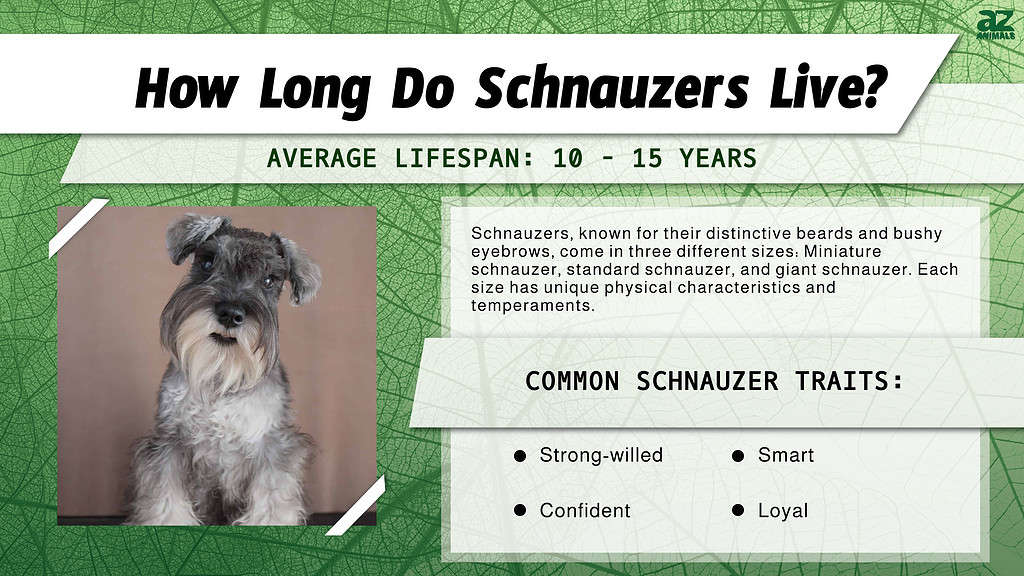If you have ever met a schnauzer, you probably are aware of how playful and happy they can be. These intelligent and vigilant dogs make great playmates and exceptional guard dogs, as well. Luckily, if kept in good health, these fluffy pets can stick around for a relatively long time – but just how long? This article will investigate how long mini, standard, and giant schnauzers live and learn about the important stages of life that unfold in that time. So, how long are schnauzer lifespans? Let’s find out.
Background
Types of Schnauzers

Schnauzers have a distinctive and adorable beard with a set of fluffy eyebrows, as well.
©everydoghasastory/Shutterstock.com
Schnauzers, known for their distinctive beards and bushy eyebrows, come in three different sizes: Miniature schnauzer, standard schnauzer, and giant schnauzer. Each size has unique physical characteristics and temperaments, making them popular choices among dog enthusiasts worldwide.
The Miniature Schnauzer

Miniature schnauzers are adorable, small dogs that make excellent companions.
©Oakland Images/Shutterstock.com
The miniature schnauzer is the smallest of the three. Standing at around 12 to 14 inches tall and weighing 11 to 20 pounds, these compact dogs exude charm and intelligence. Their wiry coat is typically salt and pepper or solid black, and regular grooming is essential to maintain their distinctive appearance. Miniature schnauzers are lively, and affectionate, and make great companions for families and individuals alike. They are known for their playful nature and adapt well to different living environments, from apartments to larger homes. Alert and quick-witted, they make excellent watchdogs, often barking to alert their owners of any potential threats.
The Standard Schnauzer

Standard schnauzers are a medium-sized dog.
©Rittis/Shutterstock.com
The standard schnauzer is a mid-sized variety, measuring between 17.5 and 19.5 inches tall and weighing 30 to 45 pounds. With their elegant appearance and a dense, wiry double coat, they have a distinguished presence. Standard schnauzers have a rich color range that includes salt and pepper, partial black, or a solid black coat. These dogs are versatile and can excel in various roles, including being a loyal family dog, a skilled working dog, or even participating in canine sports and competitions. They are smart, confident, and have a strong-willed nature, requiring consistent training and socialization to channel their energy positively.
The Giant Schnauzer

Giant schnauzers are the largest of the schnauzer varieties.
©Rita_Kochmarjova/Shutterstock.com
The giant schnauzer is the largest of the three, standing 23.5 to 27.5 inches tall and weighing 65 to 95 pounds. Robust and imposing, they have a striking appearance with a dense, wiry, and weather-resistant coat. Black is the most common color for giant schnauzers. Despite their size, giant schnauzers are gentle giants at heart. They are fiercely loyal and protective of their families, making them excellent guard dogs. With proper training and socialization from an early age, they can be well-mannered and loving pets. Their mental acuity and high energy levels require regular exercise and stimulation to keep them happy and healthy.

Life History

It is critical that schnauzers have opportunities to socialize with other dogs and humans during their early development.
©Rita_Kochmarjova/Shutterstock.com
Life history refers to the complete sequence of events and developmental stages that an organism undergoes from birth to death. In the case of schnauzers, their life history encompasses various critical phases that shape their physical and behavioral traits throughout their lifetime. From the moment they are born, schnauzer puppies go through a delicate period of development. During the first few weeks, they rely entirely on their mother for nourishment and protection.
As they grow, their senses and motor skills begin to develop, and they start exploring their surroundings, interacting with littermates, and learning essential social behaviors. This early socialization lays the foundation for their future temperament and ability to interact with humans and other animals.
As schnauzers progress into adolescence, they undergo a significant period of growth and maturation. The puppy’s playfulness remains, but their energy levels increase as they become more active and curious about the world. Training and socialization become paramount during this stage, as they begin to test boundaries and establish their place within the family hierarchy.
Proper guidance and consistent reinforcement are crucial in shaping their behavior and preventing any unwanted habits from forming. As they continue to mature, usually reaching full physical size by around 18 months to 2 years of age, Schnauzers typically settle into their adult temperament. Their personality traits, such as loyalty, intelligence, and alertness, shine through as they become more confident and self-assured.
Schnauzer Lifespan

Mini schnauzers tend to live longer than standard or giant schnauzers.
©iStock.com/Wirestock
The lifespan of miniature schnauzers, standard schnauzers, and giant schnauzers can vary based on various factors, including genetics, diet, exercise, and overall health care. On average, a miniature schnauzer’s lifespan tends to be the longest among the three, with a life expectancy of around 12 to 15 years. With proper care, some miniature schnauzers have been known to live even longer, reaching their late teens.
A standard schnauzer lifespan is around 12 to 15 years, similar to their smaller counterparts. However, some individuals may live slightly shorter or longer depending on their health and lifestyle.
Giant schnauzers have a somewhat shorter life expectancy compared to miniature and standard schnauzers. On average, they tend to live around 10 to 12 years. Again, with excellent care and attention to their health needs, some giant schnauzers have been known to surpass this average and live into their early teens.
The photo featured at the top of this post is © Rita_Kochmarjova/Shutterstock.com
Thank you for reading! Have some feedback for us? Contact the AZ Animals editorial team.







